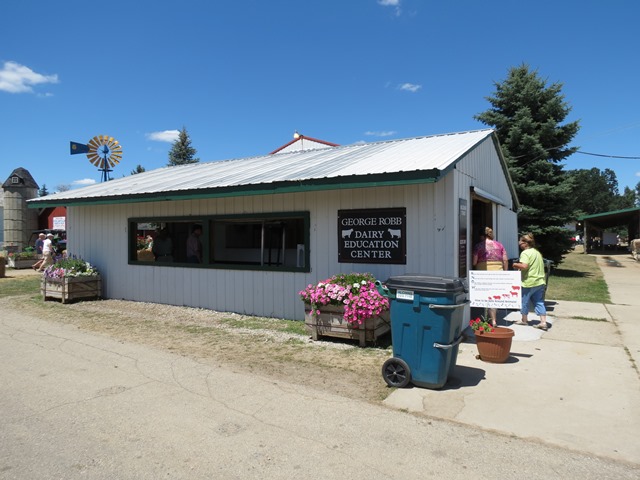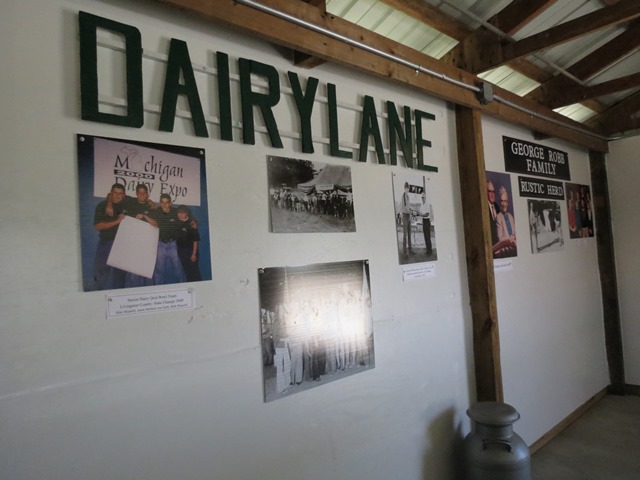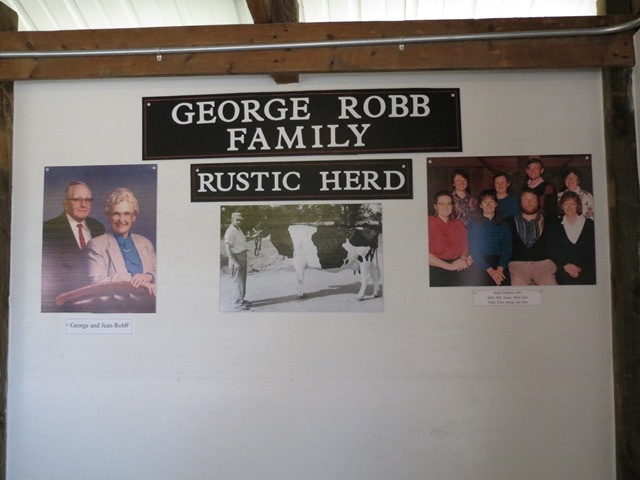By Melissa Hart
Fowlerville, Michigan--What began as a functional milking parlor for dairy exhibitors was commandeered years later for a storage shed. But this year, the Fowlerville Fair Board moved the junk out and made room for consumer education thanks to the forethought of former 4-H member, dairy farmer and Holstein breeder, the late George Robb.
“Just before George died he called up and said he had some money set aside for 4-H,” explained Fowlerville Fair Board member, Gordon Munsell. After his passing in 2005, a sum of money was gifted to Livingston County 4-H that would not only renovate the milking parlor back to functionality but would enhance consumer education as well. And at the 2013 Fowlerville Fair the George Robb Dairy Education Center became a reality.
With a wide open viewing window, visitors are able to interact and watch how cows are milked and learn how milk is processed. “Each day we have set milking times with people who come in and demonstrate how to milk a cow. We were able to purchase a new vacuum pump and a clear acrylic bucket milker so people can see the milk coming from the cow into the bucket,” said Michigan State University Extension 4-H educator Teena Munsell.
Education is paramount as dairy farm facts decorate the walls along with a historic walk down memory lane. Pictures of past 4-H members at the fair, a slate of dairy farmers from Livingston County, the Robb family and black and white pictures of George Robb and his colleagues offer visitors a lesson in dairy history of Livingston County.
Like so many dairymen of today, George whet his appetite for Registered Holsteins as a young 4-Her when he began his dairy career. George purchased his original heifer, Bess Forbes Ormsby Belle, from a breeder in East Lansing named Hugh Aldrich in 1936. Although “Belle” produced mostly bull calves they provided the means for George to purchase young grade heifers and when he graduated from high school, he went into partnership with his father Ross Robb and brother Harold. As he began to develop his herd, most of the grades were replaced with Registered cattle that could be traced back to one cow: Wilson-co Segia Maid.
By 1957, not only had George’s family begun to grow, but his ambition for breeding good Registered Holsteins had bloomed and he bought out the partnership and began cultivating and refining his own herd of cows named “Rustic” herd. George claimed his herd of cows was a “farmer’s herd,” operated under ordinary farm conditions where the family milked them twice a day and raised their own feed. It was this “farmer’s herd” that made it possible to raise a family of eight children, pay all the bills and achieve a debt free status.
By 1966 his family had grown to eight children and a year later, he had a partial herd dispersal. Promotion of the Rustic Herd was easy with the accomplishments of George and his keen sense of breeding. He had bred or developed eight bulls that went into AI service, four of which received Gold Medal status. He had bred and developed five Gold Medal Dams of which three were the breed’s first group of Gold Medal full sisters. In his short time he had bred and developed ten excellent cows and received the Holstein Association’s Progressive Breeders Award for eight consecutive years.
Well known owner of Rainbow Farms and mentor of George, the late Robin Carr zeroed in on George’s uniqueness in a 1957 story for Holstein-Friesian World, “In 50 years of observation of the progress of home-bred herds started from scratch by young men, with modest investment, I have never witnessed as much progress as George Robb has made with his neighboring “Rustic” herd here at Fowlerville, Michigan. I am talking of a program that has bred an entire herd, not assembled it. George started with plenty of enthusiasm, ambition and fidelity to what was really important, rather than with what might be currently popular blood. And so our congratulations go to George Robb because he has worked hard and earned results that area about as high as you can find in any herd, even where lots of money has been available. There is no substitute for the ability and judgment he has used, nor for the wonderful good fortune which has run hand in hand with his persistent hopes and plans. Every weathered breeder will agree that it takes this combination to achieve any great degree of success.”
In 1973 a second dispersal was held and a final dispersal in 1978 would take all the milk cows and leave the farm with heifers and cash crops. George continued to be active in the Registered Holstein business with cattle at a daughter and son-in-law’s farm.
Together, George and his wife Jean raised 6 daughters and two sons on that 160 acre farm on Robb road in Fowlerville. They were active in their local school, church and served on various boards of directors and associations.
With children, grandchildren and great grandchildren spread around the country, the Robb family continues to come home to Robb road for family gatherings.
While a fraction of the family members are active in agriculture today, the entire family is rooted in agriculture by one man and his ambition to raise a family on a farm and develop a solid herd of Registered Holsteins remembered as Rustic Herd.

The George Robb Dairy Education Center was made possible by a gift from 4-H enthusiast George Robb of Fowlerville, Michigan.

Dairy Lane: History and dairy facts line the wall of the milking parlor.

George and Jean Robb raised 8 kids on their farm in Fowlerville Michigan. George and Jean are on the left while the eight kids are pictured on the right. Front L to R: Julie, Margie, Ross, Patty. Back L to R: Mary Jane, Susan, Bill and Sally. They are all married with children and grandchildren and great grandchildren living all across the country.